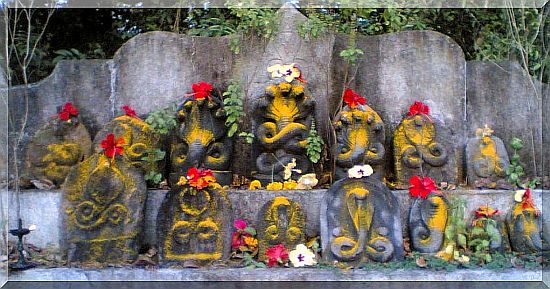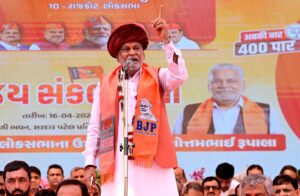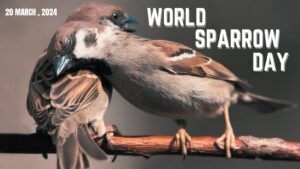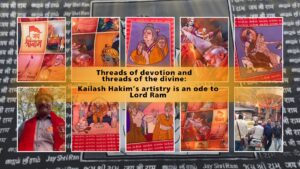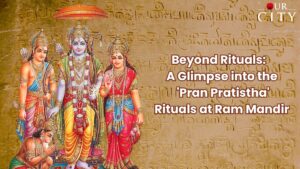Indian festivals are eagerly anticipated since they are always distinctive in their own way. We live on a land which worships mystic ideologies, ancient traditions, and a rich cultural heritage. Our festivals are well-known throughout the world for being enormous, vibrant, and having unique folklore.
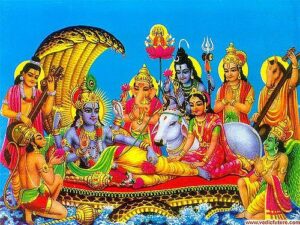 Most of us worship huge number of deities. And among these countless Gods and Goddesses, snakes make up an important portion. With other well-known deities, animals and birds have their own position in Hindu mythology as gods and demigods. Snakes are venerated, along with bears, tigers, peacocks, monkeys, cows, elephants, and so on. Thus, the worshippers of Lord Shiva and Vishnu who are intimately associated with snakes and serpents, celebrate Naga Panchami every year in the month of Shravan.
Most of us worship huge number of deities. And among these countless Gods and Goddesses, snakes make up an important portion. With other well-known deities, animals and birds have their own position in Hindu mythology as gods and demigods. Snakes are venerated, along with bears, tigers, peacocks, monkeys, cows, elephants, and so on. Thus, the worshippers of Lord Shiva and Vishnu who are intimately associated with snakes and serpents, celebrate Naga Panchami every year in the month of Shravan.
The Serpent Day
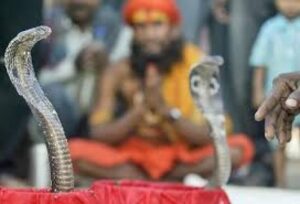 Naga Panchami is a day celebrated on the fifth day of Sravan every year. Given its rich mythological legacy, it makes sense that India annually celebrates Naga Panchami in honour of snakes. People bathe the snakes in milk during the festival to protect their family from the danger of snakes. According to legend, it is prohibited to plough a field on this day. It is a day that celebrates the co-existence of flora and fauna that reside within the biosphere.
Naga Panchami is a day celebrated on the fifth day of Sravan every year. Given its rich mythological legacy, it makes sense that India annually celebrates Naga Panchami in honour of snakes. People bathe the snakes in milk during the festival to protect their family from the danger of snakes. According to legend, it is prohibited to plough a field on this day. It is a day that celebrates the co-existence of flora and fauna that reside within the biosphere.
From the Puranas
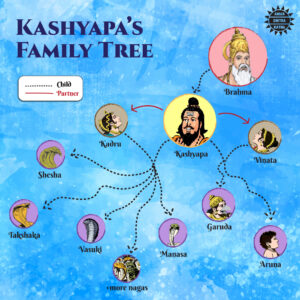 Indian mythological texts including the Agni Purana, Skanda Purana, Narada Purana, and Mahabharata provide information on the history of snakes and promote snake worship. The Puranic belief holds that the origin of Nagas may be traced back to Lord Brahma, which explains why people consider them lucky. Kashyapa, the son of Brahma, is said to have had four wives. First is the mother of all Devas, second to Garudas, third to Nagas, and fourth to Daityas. The Nagas are also known as Kadrooja because of Kashyapa’s third wife, Kadroo, who gave birth to them. They were also ones to look after the Patal Loka previously.
Indian mythological texts including the Agni Purana, Skanda Purana, Narada Purana, and Mahabharata provide information on the history of snakes and promote snake worship. The Puranic belief holds that the origin of Nagas may be traced back to Lord Brahma, which explains why people consider them lucky. Kashyapa, the son of Brahma, is said to have had four wives. First is the mother of all Devas, second to Garudas, third to Nagas, and fourth to Daityas. The Nagas are also known as Kadrooja because of Kashyapa’s third wife, Kadroo, who gave birth to them. They were also ones to look after the Patal Loka previously.
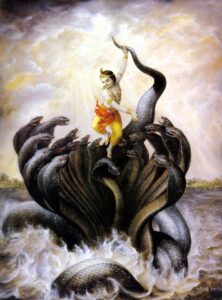 Another story revolves around the defeat of Kaliya Naga by Lord Krishna, the snake and his wives begged for Krishna’s life when they realised he was no ordinary child. After receiving his assurance that he wouldn’t continue to bother the Gokul inhabitants, Krishna decided to spare his life. To commemorate Krishna’s triumph over Kaliya naga, Naga Panchami is observed.
Another story revolves around the defeat of Kaliya Naga by Lord Krishna, the snake and his wives begged for Krishna’s life when they realised he was no ordinary child. After receiving his assurance that he wouldn’t continue to bother the Gokul inhabitants, Krishna decided to spare his life. To commemorate Krishna’s triumph over Kaliya naga, Naga Panchami is observed.
The Nine Nagas
अनन्तं वासुकिं शेषं पद्मनाभं च कम्बलम् |
शंखपालं धार्तराष्ट्रं तक्षकं कालियं तथा |
The following shloka has names of the nine great Nagas from mythology; Ananta, Vasuki, Sheshnag, Padmanbha, Kambala, Shankhapla, Dhritrashtra, Takshaka, and Kaliya.
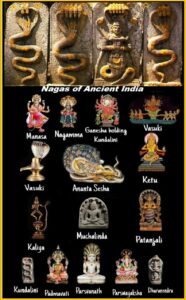 On the day of Naga Panchami, worshippers offer milk, sweets, flowers, and light diyas to Nagas. On this occasion, snake paintings are painted on the walls and doorways outside the house, along with fortunate mantras. Such representations are thought to frighten off deadly snakes. The following mantra are recited while worshipping images of the Naga deities.
On the day of Naga Panchami, worshippers offer milk, sweets, flowers, and light diyas to Nagas. On this occasion, snake paintings are painted on the walls and doorways outside the house, along with fortunate mantras. Such representations are thought to frighten off deadly snakes. The following mantra are recited while worshipping images of the Naga deities.
नाग प्रीता भवन्ति शान्तिमाप्नोति बिअ विबोह् |
सशन्ति लोक मा साध्य मोदते सस्थित समः |
(We all salute and pray for the blessings of the snakes who live in this world, the sky, heaven, the sun, lakes, wells, ponds, etc.)
Bhratru Panchami
In addition to being known as Naga Panchami, this day is also known as Bhratru Panchami when women who have brothers worship snakes and the holes they live in while praying to nagas for protection from being bitten. In various regions of the nation, the Naga Panchami is also observed as Vishari Puja or Bishari Puja, where Bisha or Visha is the Sanskrit word for “poison”.
Due to a degree of terror generated by the notion that snakes possess greater power than people and because of its affiliation with Lord Shiva, Vishnu, and Subramanya, Hindus have deified the cobra and worship it in all of the nation.
In Astrology
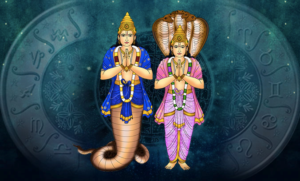 Hindu astrology associates the snake with the Moon’s nodes. Rahu (“Dragon’s head”) and Ketu (“Dragon’s tail”) are each a symbol for one of the snake’s parts. A person is said to have Kalasarpa dosha (a defect caused by black snakes) if all seven of the major planets in their zodiacal chart are sandwiched between Rahu and Ketu in the opposite direction from how they should be (anticlockwise). This defect can be remedied by offering snake worship on the day of Naga Panchami.
Hindu astrology associates the snake with the Moon’s nodes. Rahu (“Dragon’s head”) and Ketu (“Dragon’s tail”) are each a symbol for one of the snake’s parts. A person is said to have Kalasarpa dosha (a defect caused by black snakes) if all seven of the major planets in their zodiacal chart are sandwiched between Rahu and Ketu in the opposite direction from how they should be (anticlockwise). This defect can be remedied by offering snake worship on the day of Naga Panchami.

